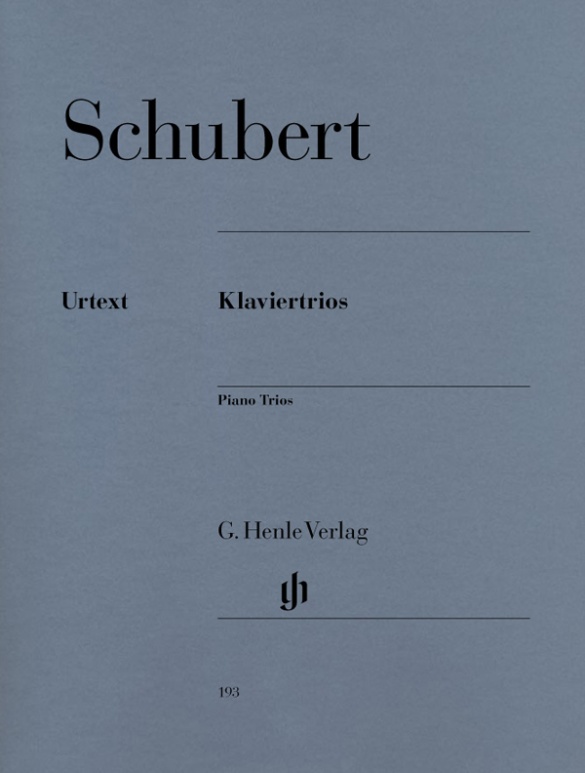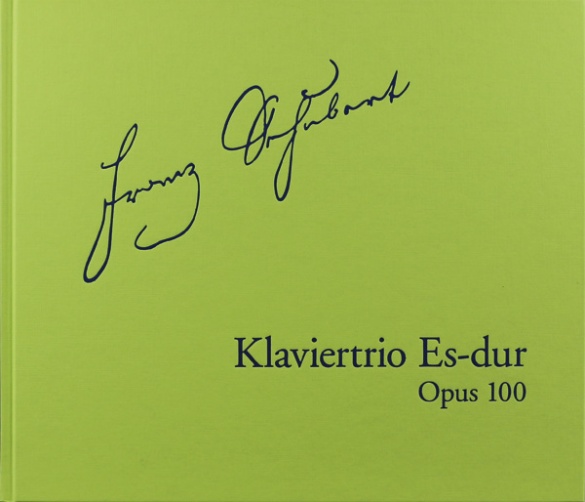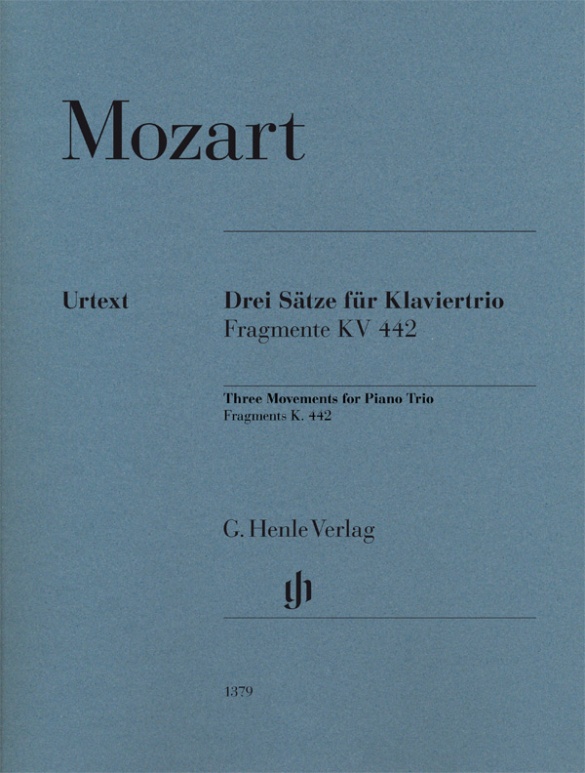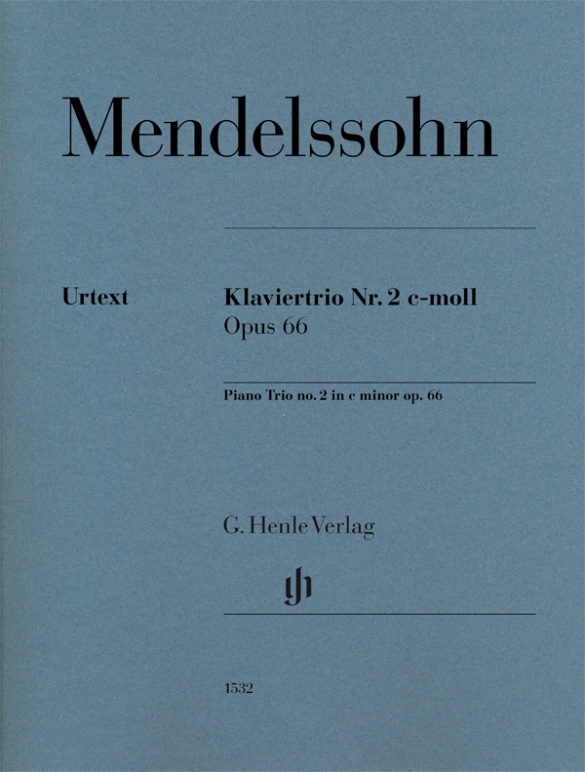Franz Schubert
Piano Trios
One needn’t hesitate a second in assigning Schubert’s two piano trios to his best works. Both were written no later than 1827, hence one year before the composer’s death, and are typical works of his maturity: abounding in blissful melodies paired with formative power and profound depths of expressiveness. Whereas Schubert had sold the E flat major Trio op. 100 D 929 to the Leipzig publisher Probst (it appeared just after Schubert’s death, however), the B flat major Trio op. 99 D 898 did not make it to publication during Schubert’s lifetime.The Adagio in E flat major op. post. 148 D 897, which is reproduced in the Appendix and which has become known as Notturno, was most likely originally planned as the slow movement of the B flat major Trio. With its expressiveness ascending to darkest despair, Schubert possibly considered it as unsuited for publication.It was not published until 1846; in the Appendix of this volume one will find Schubert’s first attempt in this genre, which he wrote at the age of 15 in summer 1812.
内容/詳細
作曲家について
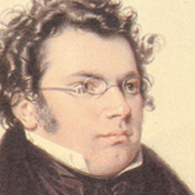
Franz Schubert
He is not only the inaugurator of the art song and its most important composer in the nineteenth century, but he also realized a compositional concept in his instrumental works that opposed Viennese Classicism. Underlying the “heavenly length” of his works is a configuration of time that does not function according to the principle of motivic development, but addresses the notion of lingering; modifications occur mostly not in continuous unfolding, but through sudden eruptions. His ornate songs contradict the ideal of simplicity in the Lied aesthetics of his time, and provide the basis for the art song of the nineteenth century, regarded as they were as exemplary by subsequent generations of composers; they are defined by complex harmonies, an integration of the idioms of instrumental music, semantic models, and a new relationship between text and music in which the poem as a whole is interpreted through the composition, rather than just through word painting. His immense oeuvre in spite of his brief life comprises 600 songs, including his two famous song cycles; seven complete and several unfinished symphonies (including the “Unfinished” in B minor); other orchestral works; numerous pieces of chamber music; fourteen complete and several unfinished piano sonatas as well as other piano pieces; dances for piano and four-hand works; six masses and other sacred compositions; numerous pieces for choir or vocal ensemble, especially for male voices. Although he also contributed to every genre of music theater and his friends predicted a career for him in opera, only two of his ten finished operas were performed during his lifetime, as was the incidental music to “Rosamunde.”
| 1797 | Born in Himmelpfortgrund near Vienna on January 31, the son of a teacher. First piano lessons from his brother Ignaz, violin lessons from his father at age eight. |
| from 1808 | Choirboy in the Imperial Chapel; attends the imperial and royal boys choir school (“Stadtkonvikt”), playing violin in its orchestra. Lessons from Antonio Salieri, who attempts to win over the boy enamored with Mozart, Haydn, and Beethoven to Italian opera. First surviving compositions. |
| 1811 | Composition of his first song, “Hagars Klage.” |
| 1813–14 | Attends the pedagogical secondary school, after which he teaches in his father’s school. |
| 1813/14 | Composition of the magical opera “Des Teufels Lustschloss” and the Symphony No. 1 in D major in classical form. |
| 1814 | Composition of the Mass in F Major, D 105. He writes songs, which he groups by their poets, e.g. Matthisson and Goethe, including “Gretchen am Spinnrade,” which marks the birth of the art song. |
| 1815 | Composition of the musical comedy “Claudine von Villa Bella” after Goethe and “Der vierjährige Posten.” Completion of the Symphony No. 2 in B-flat major and composition of the Symphony No. 3 in D major as well as the Masses in G major and No. 3 in D major; the song “Erlkönig,” among others. |
| 1816 | Composes 110 songs, the Symphonies No. 4 in C minor and No. 5 in B-flat major, and the Mass in C major. He leaves his parents’ home, suspends his position as teacher, and moves in with Schober. |
| 1817 | Sixty songs, including “Der Schiffer,” “Ganymed,” “An die Musik,” “Die Forelle,” “Gruppe aus dem Tartarus,” “Der Tod und das Mädchen.” Gradually his compositions are performed (his oeuvre already comprises around 500 works). Returns to his parental home. |
| 1818 | He teaches the daughters of Count Johann Karl Esterházy. Composition of four-hand piano pieces. |
| around 1819 | Composition of the Piano Quintet in A major (“Trout” Quintet). |
| 1820 | Premiere in Vienna of the melodrama “Die Zauberharfe” and the musical comedy “Die Zwillingsbrüder.” The song “Frühlingsglaube,” among others. |
| 1821 | First Schubertiade: a convivial musical- and literary evening meeting of Schubert’s circle of friends. Publication of the songs “Erlkönig” and “Gretchen am Spinnrade” as well as other Goethe songs and 36 dances. |
| 1821–22/54 | Composition/premiere of “Alfonso und Estrella,” one of the early through-composed German operas. |
| 1822 | Completion of the Mass in A-flat major; Symphony No. 7 in B minor (“Unfinished”); Wanderer Fantasy in C major for piano, which unites in one movement the four different characters of symphonic movements. |
| 1823 | Composition of the musical comedy “Die Verschworenen” (premiere in Frankfurt am Main in 1861), the heroic-Romantic opera “Fierrabras” (premiere in Karlsruhe in 1897), and the incidental music to “Rosamunde,” which is premiered in Vienna. Song cycle “Die schöne Müllerin,” songs “Auf dem Wasser zu singen,” “Lachen und Weinen,” among others; Piano Sonata in A minor, D 784. |
| 1824 | Once more teacher of the children of Count von Esterházy. String Quartet in D minor (“Death and the Maiden”). “Wandrers Nachtlied” (“Über allen Gipfeln ist Ruh”). The piano sonata takes on greater importance. |
| 1825 | Long holiday travels, including to Gmunden-Gastein, where he composes the Great Symphony in C major (No. 9 or No. 8), in which he considerably expands classical form (e.g. horn motto at the beginning, configuration of time). |
| 1827 | Song cycle “Winterreise” (contrasts dream sequences with reality); German Mass; four Impromptus for piano; Piano Trios in B-flat major, D 898, and E-flat major, D 929. |
| 1828 | Publication of the “Six Moments Musicaux” for piano. Composition of the last three piano sonatas in C minor, A major, and B-flat major (the latter with a tendency towards the esoteric), the sonata movement in A minor (“Lebensstürme”), the Mass in E-flat major. “Thirteen Songs after Poems by Rellstab and Heine” (posthumous “Schwanengesang,” “Swan Song”). In March, a concert dedicated to only his own music. Death in Vienna on November 19. |
校訂者や運指担当者について
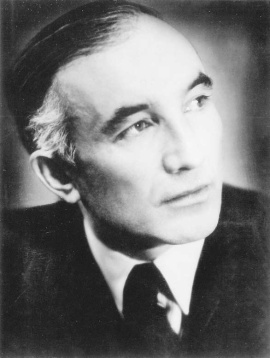
Hans-Martin Theopold (運指)
Prof. Hans-Martin Theopold, was born to a pastor’s family in Detmold on 22 April 1904, the youngest of five children. Even as a child he often played the organ in the “Marktkirche” and soon began to take piano lessons with Theodor Vehmeier. At the age of 17 he made his debut at the Landestheater in Detmold with Ludwig van Beethoven’s Piano Concerto in C major under Friedrich Quast (Herford). Following the successful completion of his schooling at the Gymnasium Leopoldinum in Detmold, he went on to study music and piano (main subject): from 1922–23 at the “Württembergische Hochschule für Musik” in Stuttgart (with Max Pauer, 1866–1945) and then from 1923–1928 at the “Staatliche Akademische Hochschule für Musik” in Berlin-Charlottenburg (with Richard Rössler, 1880–1962, and Waldemar Lütschg, 1877–1948). After completing his piano studies (graduating with “very good”) in 1928, he began an active solo career both at home and abroad (USA, Switzerland, Scandinavia, the Baltic states, the Balkans). As a member of the Chamber Music Association of the State Opera in Berlin (from 1933) he also gave countless chamber music concerts, including ones with his violin partner Gustav Havemann (1882–1960).
In the 1930s, audiences and the press alike raved about Theopold’s extraordinary gifts as a pianist: “This young player has it in him to soon become one of the best players in Germany. A superior technique, a wonderful singing piano tone, the strength of a Titan, but not at all hard due to the incomparably gentle elasticity of his touch” [Münchener Zeitung, 21 November 1933]. – “H.M. Theopold gave convincing proof of his splendid pianistic ability in an extremely gripping sonata with a modern idiom by Alban Berg, but predominantly in Schubert’s […] Wanderer Fantasy, which he played with a polished technique and creative power” [Weser-Zeitung, 21 December 1932]. Theopold was awarded several prizes, including the “Grotrian-Steinweg-Preis” in 1928.
In 1937 Theopold became a teacher for the piano (main subject) at the “Bayerisches Staatskonservatorium der Musik” in Würzburg. In 1939 he married Irene Tatjana Wülfing, who was from Moscow. From 1943 he became head of the piano master-class at the “Nordische Musikschule” in Bremen, although this was interrupted by the events of the war. Following his return from a prisoner of war camp, Theopold gave concerts and taught although he did not hold a permanent position. From 1955–1956 he was acting head of the piano master-class at the “Bergisches Landeskonservatorium” in Wuppertal, finally being appointed Professor for Piano on 1 April 1956 at the “Staatliches Institut für Schul- und Volksmusik” in Detmold, later at the “Nordwestdeutsche Musikakademie Detmold” (today “Hochschule für Musik Detmold”), where he taught for decades. On 30 September 1969 he retired. “His students extol his pedagogical gifts. […] Humour, charm, helpfulness and kind-heartedness moderate the strictness of his professional ethos as a musician and teacher” (Lippische Rundschau, 23 April 1969; see also: Lippische Landeszeitung 22 April 1969 on the occasion of Theopold’s 65. birthday: “Prof. Theopold, a modest but at the same time energetic man, is an enthusiastic teacher”). Theopold died in Detmold in 2000.
Contact with Günter Henle was established directly after the publishing house was founded, when Theopold thanked the publishers with great enthusiasm for its first Urtext editions. His extensive correspondence with the publishing house was bequeathed to the Lippische Landesbibliothek in 2014 to ensure its long-term accessibility to the public. The letters testify not only to Theopold’s great interest in musical sources and text questions but also to his initial strict refusal (!) of fingerings in text-critical editions such as these: “For fingerings are and remain something individual no matter what their quality” (letter to Günter Henle from 26 May 1949 {publishing house archives}). Günter Henle was not, however, to be swayed and stressed the necessity of fingerings in his Urtext editions: “It is better to publish the Urtext […] with fingerings that are not necessary for a few individuals, or that might even, I admit, be considered irritating here and there” (letter to Hans-Martin Theopold of 17 September 1953).
It was only in 1955 that Theopold accepted Günter Henle’s offer of contributing fingerings for an Urtext edition that was in the process of being prepared by way of trial. (HN 74, Schubert, Complete Dances for Piano, Volume 1). Following this, Theopold was commissioned to write the fingerings for nearly all of the publishing house’s new editions in quick succession. Günter Henle, himself a good pianist, greatly valued Theopold’s fingerings, and also the many suggestions regarding the musical text in question. In addition, Theopold was always very reliable, thorough and conscientious – something that is not unimportant with editorial work!
Thus to date Hans-Martin Theopold has provided the fingerings for the greatest number of Henle Urtext editions by far – 226 editions (!) in total.
We would like to thank Mrs Margot Theopold and the Hochschule für Musik in Detmold for their great support in providing biographical material.
G. Henle Verlag
製品安全に関する情報

G. Henle Verlag
製品の製造元に関する情報はこちらでご覧いただけます。G. Henle Verlag
Forstenrieder Allee 122
81476 München
info@henle.de
www.henle.com
おすすめ
autogenerated_cross_selling
このタイトルを含む他の版


